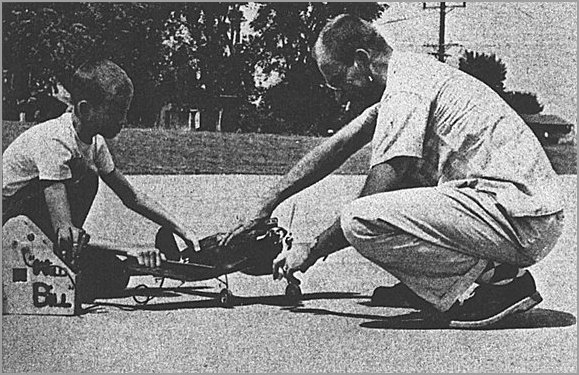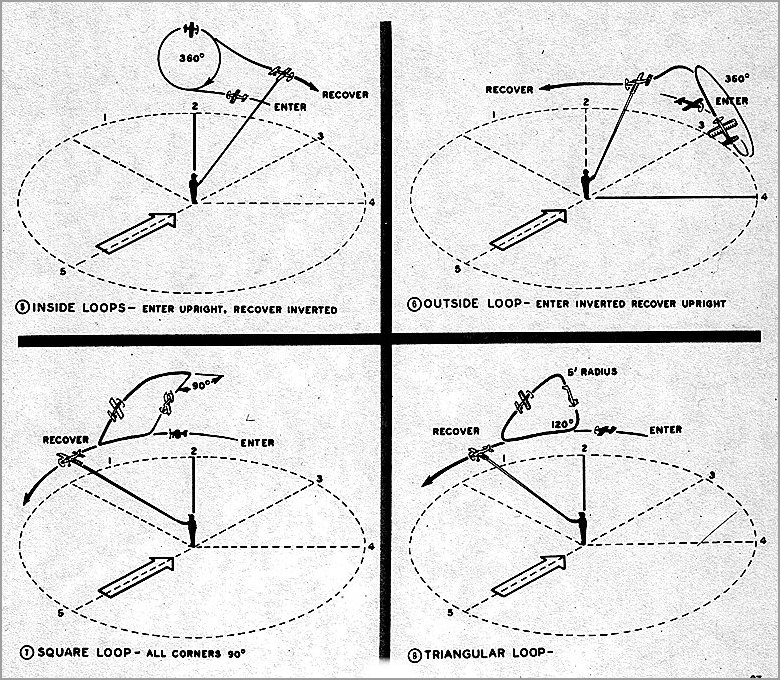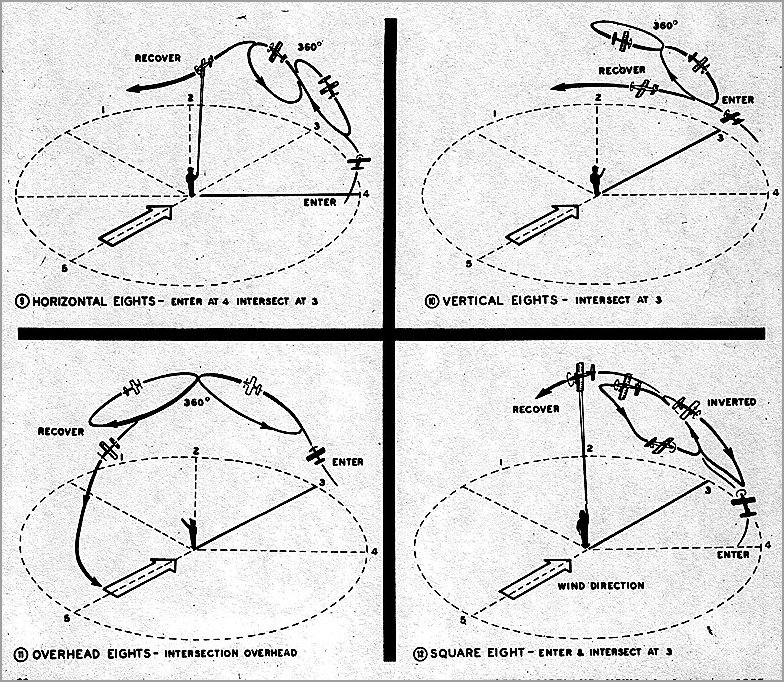
Wild Bill cranks up his scale Corsair for the Carrier ivent. Earnest helper is learning the trade.
And look at that smooth ground!

The author has found that a judge will unconsciously form an opinion of your style of flying which will affect decisions on close ones. No judge is going to give full points for a pattern during which the flier wanders all over between maneuvers or where our hero forgets to leave a level lap or two between maneuvers; simply because the judge cannot tell whether the flier is doing a maneuver or just messing around. So try this. After determining that your. engine is running properly, signal for a full lap and then fly your two laps of level flight. In between maneuvers return to normal level flight altitude, except between climb and dive, and give him time to record your last maneuver. He'll appreciate it and you'll come out ahead. Make your entries into maneuvers positive and if you should mess up, do not try that one again, go on to the next. You will lose pattern points for at- tempting the same maneuver over. Learn the pattern, commit it to memory and when practicing go through it in order every time. Get used to the sequence.

To be more specific, let's go through some fine points. Wind is a nasty word to some fliers. It isn't nearly as frightening as it's cracked up to be. In fact the wind can be made to work for you, if you know how. The illustrations show five points on the circle relative to the wind direction. Also shown are the entry points for the various maneuvers. This is based on eight years of flying stunt. Select something which will indicate the wind direction such as a flag or pennant. Make sure you know where the wind is blowing from at all times; it shifts, you know. On your practice field you will probably find landmarks which you will use according to the prevailing wind. At a contest, the judges will usually place themselves on the upwind side of the circle, but they may place their backs to the sun, so don't use them for a wind sock til you've checked. Pick out your own reference point for various maneuvers before you fly and keep a sharp lookout for wind shifts. After you have flown your ship for a while it will become apparent how much it is affected by wind. Be consistent is good advice. You will find that through the astute use of wind you can fly a much heavier plane than in calm weather.
The author prefers a heavy plane for several reasons. A more sedate type of flight is achieved with less bouncing around from wind. Maneuvers can be flown through, as opposed to the "which way'd he go" of a high-speed job. More time for thought is allowed with this type and there is a better chance of getting out of trouble if a slip is made.
Most stunt men will recommend practice makes perfect. For the majority this is true. However, the author found that the more he practiced, after learning and getting used to the motions of the pattern, the worse he got. Some people cannot do routine things well. Repetition seems to louse them up. The Gold Brick's last eight flights were made at four contests, widely separated with no practice in between. we point this out merely to show that some of you will get worse if you practice constantly. If you get better with practice, then do it. The main thing is to get the motions of the pattern down pat so you can concentrate on the details of terrain and wind.

To get back to the illustrations for a moment, these entry positions were selected for various reasons. You'll notice that the only time you will maneuver on the up-wind side is on the wingover. we start them up-wind to make it easier to fly a truly vertical line. Loops are done up-wind to prevent walking, or each successive loop moving forward. The eights are started directly down wind to give maximum tug and to aid in keeping them round. Study the rules carefully and make all entries as prescribed. If you make a mistake, go along like you knew what you were doing. A sharp judge will catch you anyhow, but sometimes you can get by with it. Grimacing or throwing a fit will call attention to it like a Bikini on Main Street.
A simple trick to get a smooth pattern is to set your engine rich in level flight, just below the point where it runs 2 cycle. Then when you maneuver the ship your engine will peak out and compensate for the increase in drag. So your ship moves at roughly the same speed all the time. Peak the engine at the start and you are dead. Remember too, you have three attempts for two official flights. If you don't like your engine run, don't signal. we goofed in '55 with a lean run which could have been an attempt. I have one engine which hauls nothing but my stunt job. This way, I know exactly how it should sound for a good run. Changing around causes confusion. When you have finished your flight, clean up your ship and cover the engine. Stay away from the judges. They know what they are doing and you have done all you can in the circle. They can do a much better job if they aren't pestered by helpers, spectators and fliers crowding around and cutting off the air.
If you get a chance to fly in calm weather here are a few tricks to use if your ship isn't perfect. If it turns tightly enough but not too smoothly, do your round maneuvers coming into the judges. Then they can see the height of your loops but it's difficult to judge the smoothness. If the opposite is true, that is smooth but wide, do them right in front of our friends so they see the shape but not the size. Again these tricks won't work on all, but there are possibilities. Of course, it's better to have a good all round ship.
We will get into design later, but for the present most of you are probably flying kit jobs. How did you pick the one you bought? Color of box, wild claims, past performance, or what? It has become apparent to us over the years, that each person must find a ship that suits his personality. For instance: If you are naturally slow moving and methodical you will be ill matched with a red hot, sensitive bomb. Your natural pace will be disrupted and you will find yourself behind the ship roost of the time simply because, while you are making up your mind to do something, the plane will have done it. If, however, the plane is fairly slow and easy you'll be right in harmony and can turn out a real fine pattem. The high gear, up-and- at-em pilot will get just as nervous and tight with a slow ship as a laxy bum will with a rocket ship. If you don t know which type you are, ask your best friend, or if rich, your psychiatrist. We do not mean you can't fly an opposite airplane, but we are trying for an optimum mating of pilot and airplane. The Air Force is very much interested in personalities when deciding on pilot classification, such as bomber or fighter. We can do well to step back and look at ourselves also.

How can we tell how a ship will perform by looking at the box? A real good estimate is the size. Most modern ships of 500 sq. inches or more will stunt at 70 MPH or under. The cleanness of the design is another factor. A small squared-off ship may be slow, while a clean large one may be real fast. We can adjust speed somewhat with props and engine runs, but each ship will have an optimum operating air speed. Try to find one of the type ships you are interested in and watch it fly. Observe the way it turns sharp corners and round maneuvers. Ask the man who owns one and try to analyze what you find out objectively. If you let yourself be sold on the wrong ship for you, the time spent in building and flying is forfeit. A good contest stunt ship is a large investment of money and time and should be handled carefully. Built right and flown carefully it can last you for several years. Incidentally, cover it with silk or nylon. Lasts better.
As long as we have precision stunt, the ships we are flying now will do the job. We personally do not see any startling or profound changes in sight to obsolete them. On the strength of this it is worth the extra time spent in doingthe job right. Also it has been proved that constant changing of airplanes, even the same design, cuts down tne consistency of performance, as it takes a while to get to know your ship. This is all a matter of "Do as I say, not as I do." If your interest is experiment, have at it. we get tired of our ships the moment all the bugs are exterminated and start out after the rainbow again.
The rules book is quite explicit about how the maneuvers are performed. It has been appalling to judge some of the patterns lately since most people seem to get worse from week to week. We've seen far too many people do the 1950 style horizontal eights, wrong approach to the overhead eight and vertical eight and maneuvers out of sequence. Obviously these pilots haven't cracked a rule book for years. Have you been losing out, when you thought you were real hot? Perhaps you are still in the dark ages too. Those of you who know the pattern can close one eye for awhile.
To pick up the more obscure points, the first maneuver after deciding you can get through the pattern is a raised arm signal for at least one lap to tell the judges you are ready. Then fly your two level laps. After your climb, your flight is official, so finish it! Remain at your 45 degree altitude for three full laps and then execute your dive. The reverse wingover includes one-half lap of inverted flight, no more, no less. It is a good idea to stand in a fixed position when doing the wingover and the reverse wingover. This will help you split the circle precisely. You do three inside loops followed immediately by a half loop to get you inverted. Four laps inverted are necessary before doing outside loops. Do three outside followed immediately by a half outside to get you upright. The square loop is done with four precisely timed snaps of the wrist. Don't rush this one as you have plenty of room for it. The triangle is three snaps, with the last one scaring the socks off of everyone around. It can be done though. However, it is supposed to be equilateral, not just iscoseles.
The horizontal eights are entered at the intersection with either the outside or inside loop coming first. We prefer the inside first as do 80% of the fliers we have watched. Take pains to get both ends round and the same size. The vertical eight is entered inverted at an altitude of 45 degrees. Either top or bottom may be done first, the author preferring the top. To complete the maneuver an additional half loop is necessary to bring you out upright. Use the whole 90 degrees for this one and don't let it get too wide. Roundness is important in all three eights. Overheads are approached with a vertical climb and start immediately overhead. The two sides of the eight are on an axis normal to the approach. We approach by facing down wind and pulling up when the plane is right in front of us. The eight is then across our body and across the wind. In this way they are easily made the same size. To get out of the overhead eight, continue the same direction you entered pulling out upwind. The square eight is about 10 corners and a real nerve quaker. Again we say, "don't rush it." On the landing If you are still with us, the approach is judged as well as the touch down and rolL All must be smooth. Each ship will have its own nasty characteristic on landing and the technique is for you to find. Try both three point and wheel landings and use whichever works best. Most ships will land themselves, so just freeze the handle. Oh, we always do three quick outside loops to clear the lines before landing. After landing smoothly, walk off like you did it every time. No one needs know.
You'il find that level flight and the bottoms of all maneuvers, except over- heads, are to be at shoulder height, or 4 feet, which ever is greater. If you are 10 feet tall, fine, but us short folks have a problem. This is right close to the ground as you no doubt know. However, to get maximum points you must cut them short. We suggest using flags spaced around the circle at 6 feet or so for practice and work your maneuvers to them. After you get used to the timing it shouldn't be too hard to keep it up. See why we recommend using the same plane all the time? Good pullouts are all a matter of proper timing or lead. You must know your airplane and have enough confidence to let her ride. The difference between a good pullout and a splat is about 1/80 of a second, but it's being done every day. The latest rules have loosened up the radius requirements on climb, dive and wingovers. It's 7 feet, so take advantage of it. Watch your tendency to overoontrol on sharp pullouts which causes a bobble on the end. Something to think about: The four eights are worth 160 points while all the other maneuvers are worth 180. Work on those eights because they represent winning or losing. The others are important too so don't neglect them.
Appearance is not worth much in points, but should be a matter of pride. Once you have decided how long your lines need be, don't ever change for that ship! We have good reason for that statement. At the '54 Nats we flew? the "Hesperus" in stunt. Practice was on 60' lines but we decided to make our first official on 70' lines. Gad - what a mess. Flight resembled a wounded flounder. We had little or no tug most of the time. On 60's before and after she flew fine, not marvelous, just fine. Now we design for 67' wires and use nothing else. U-Reely users daub some paint on your wires so you'il be able to get the same length each flight.
The AMA pattern is a good one. It will tell the whole story of pilot and airplane. The climb, dive and wingovers check untimed square corr'ers. Loops show up your ability to judge flight path coincidence and smoothness. The square and triangles loop judge your timing of square corners as does the square eight. The eights are timed maneuvers which work the ship in three separate planes. Landing and take off are in accordance with the laws of nature. So after looking at a whole pattern the boys can be separated from the men with the confident feeling that all have been judged fairly and squarely. And how.
(This is the second in a series of stunt articles by this author)
